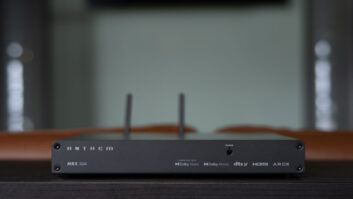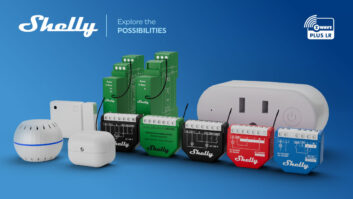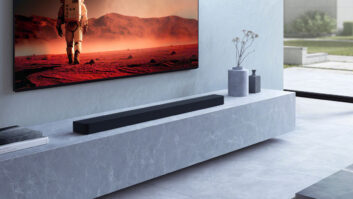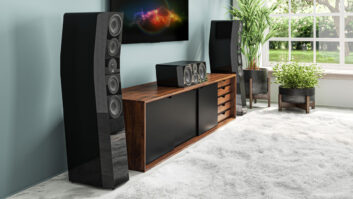If CES 2012 was any indication of what’s to come in technology trends, wireless everything is not only an ultimate reality, but it might be closer to your home than you’d think.

From gesture interface controls to voice-control Siri impersonators, the methods in which the wires are being taken out of the equation are incredibly varied, from technically advanced networking standards like the Z-Wave, ZigBee, and MoCA (technically Multimedia over Coax, but it’s responsible for powering many major set-top boxes and enabling streaming capabilities) the real story is how audio and video product manufacturers are cutting their cords.
In the video world, smart TVs have been trending strongly for sometime, with most flat-panel manufacturers introducing some latest version. LG’s includes a 3D gesture interface, network file browser capability and WiDi, Intel’s Wireless Display technology that brings your PC content to your TV, sans dongle.

NETGEAR’s NeoTV box turns a legacy TV into a smart one.
These “smart TVs” utilize NetCast, LG’s platform that contains more than 1,200 apps for a richer online experience. It also has better embedding of social networking services, permitting viewers to share and “like” programs they’re viewing. Additionally a new “magic remote” offers voice recognition and “magic gesture” controls, allowing users to just speak searches into the remote or use gesture to control some functions. LG is also revealing its spin on a Google TV, which will combine 3D TV technology with Google’s Android-based smart TV ecosystem.
In other developments, Samsung’s new 8-series line-up has added a host of new smart TV features, including cameras for Skype video chat and motion control.
Sharp’s Aquos series Freestyle TVs use Wi-Fi to deliver HD video to stream the sets, allowing them to be placed anywhere there is a power location. The sets encourage portability with slimmer and lighter designs than most LED TVs, and an optional hook is available.
NETGEAR had a number of interesting home networking products unveiled, including the NeoTV (previously announced), a small box that effectively transforms a legacy TV into a “smart” one, and now includes WiDi.
Also in the area of wireless home networking, Pakedge introduced its W5L wireless access point and controller late last year, which uses the company’s residential virtual cell technology to support various wireless access points (WAP) in a home to work together as one virtual WAP. This results in Wi-Fi roaming for portable devices, such as tablets, touchpanels, or VoIP phone service.
“AV systems can be sensitive, so it’s necessary to have a strong wireless network backbone as support,” said Dusan Jankov, Pakedge vice president. “Pakedge understands the needs and move toward wireless AV; therefore, we provide robust wireless systems to embrace this integration of audio/video and wireless.”

Pakedge’s W5L WAP and controller enables Wi-Fi roaming for portable devices.
Atlona has introduced its Home Collection of AV connectivity products, including the LinkCast wireless HD AV system that connects multiple HDMI-based devices wirelessly to an HDTV or projector up to 45 feet at 1080p, and further at lower resolutions. The system consists of a base station that connects via a TV or projector HDMI and an expander, essentially a dongle, which plugs into any device with an HDMI output and USB connection. Up to five devices can be connected via expanders sold separately. Atlona demo’d the system at CES on an iPad used as a gaming control.
Wireless Audio Developments
While there are clearly some cutting-edge wireless video technologies on the rise, these offerings seemed somewhat outplayed at CES by the wireless audio world. The first significant glimpse of wireless audio technology was at this past CEDIA EXPO, with updates from Sonos, Legrand, ClearOne, Monster, NuVo, Soundcast Systems, and the biggest splash from Proficient Audio’s Zero, which consists of a transmitter and amplified receiver for transmitting stereo sound up to 90 feet. The trend continued on the massmarket level at CES last month.
With the advent of ever-thinner flat-panels– CES 2012 was in some ways a battle of the biggest and thinnest TVs–custom installers have faced a design dilemma in how to pair quality speakers with video sources that increasingly blend into the wall. In light of this “thin TV dilemma,” according to Jim Venable, president of the Wireless Speaker and Audio (WiSA) Association, “this is a great time for wireless to take hold of the market.”

Atlona’s LinkCast system connects multiple HDMIbased devices wirelessly to an HDTV or projector up to 45 feet at 1080p.
Having launched in mid-December 2011, WiSA is the newest industry association determined to integrate its technology into manufactured products with founding support from an advisory board, including Summit Semiconductor (the backbone of the technology), Aperion Audio, DEI Holdings (Polk Audio and Definitive Technology parent company), Pioneer, Sharp, and Klipsch, among others. WiSA has established interoperability specification and certification testing programs for high performance, wireless speakers.
Unlike traditional Wi-Fi technology, WiSAcertified products operate on the U-NII band, an unlicensed spectrum traditionally reserved for government radar operations that provides more than 20 additional channels to what Wi-Fi has. So if a device encounters any interference on a channel, which normally results in buffering, it can automatically jump to one of the 23 other channels. Interference has been a major sticking point for wireless technology’s adoption.

Russound’s AirGo Outdoor speaker streams content using AirPlay.
The interoperability of WiSA-certified speakers ensures that different brand systems can communicate and work with each other. The speakers simply “ping” or talk to each other spanning a 10-meter-square area. All the system requires is a master device that detects the delay and distance from each other of every speaker in the area. The technology even allows speakers to be switched, adjusting in less than 30 seconds. The goal is to set up a 7.1 home theater system in less than 30 minutes.
Aperion’s Intimus 4T Summit Wireless System, includes five Intimus WiSA-certified speakers and a Bravus 8A subwoofer. Also included in the system are a built-in digital receiver and dual amplifiers, a preamp transmitter, and remote control.
Klipsch speakers were also being demo-ed in the WiSA Venetian suite at CES, but there didn’t appear to be an official product announcement since Klipsch’s booth at the show was all about AirPlay.
Venable said the association is talking to many other loudspeaker manufacturers he expects will be on board producing WiSA-compliant speakers by 2013. He couldn’t name any of these manufacturers, but he said they include, “a lot of folks you know and love.”

The B&O Play Beolit 12 is a compact, portable HiFi system featuring AirPlay.
In what was perhaps one of the biggest displays of Apple’s AirPlay at CES, Klipsch had several systems out, including the Console, designed to be a full system replacement and resembling a sleek, bureau-type piece of furniture. Klipsch demo’d the Console with a wine glass of water sitting on top that didn’t budge as the system flexed its 120dB-capable muscle. Also, Klipsch introduced the Stadium 2.1 tabletop speaker and the RoomGroove Air, the most portable offering. The Energy and Jamo brands also had a range of AirPlay offerings to share.

The Klipsch Console is designed to be a full system replacement.
Russound’s AirGo Outdoor weatherproof speaker integrates an amplifier in a case with a sealed housing designed to hold an Apple AirPort Express (sold separately). The speaker is a great portable companion for an outdoor music (see the January issue of Residential Systems to read a full product review of the AirGo Outdoor.)
Bang & Olufson launched the B&O Play brand, featuring the Beolit 12 compact, portable HiFi system with AirPlay. Designed to be truly mobile, the Beolit 12 has a built-in power supply and a rechargeable battery.
Both AirPlay and Bluetooth wireless technologies had a particularly strong showing at CES in the desktop audio category, from manufacturers such as Polk Audio, Westinghouse, Monster, Sharp, Haier, Eton, Coby, and many others.
Although the wireless audio category might be the source of a little more action in the technology and adoption areas for the moment, wireless video is being pursued in many different exciting forms as well. One thing is for sure, the future of home AV looks even better with fewer cords.
Additional reporting contributed by John Sciacca.
Lindsey Adler ([email protected]) is assistant editor for Residential Systems and SCN.







